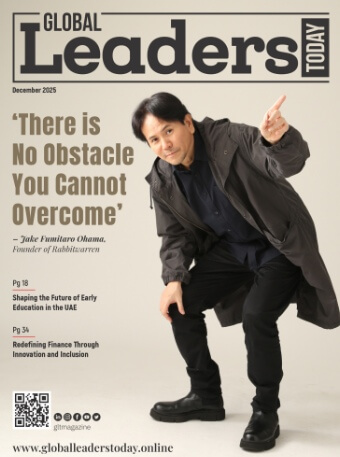- When Caring Becomes a Cage: How Over-Identification with Work Steals Your Self
- Redefining Finance Through Innovation and Inclusion
- ‘AI Prone To Errors, Use Alongside Other Tools’: Sundar Pichai
- ‘There is No Obstacle You Cannot Overcome’
- Pioneering Financial Innovation: Ali Alrawi and the Rise of Alfuras Group
Thought Leadership
A career in the hospitality and entertainment industry is a vibrant, emotional journey unlike any other. Every day pulses with new challenges, unexpected moments, and the chance to craft experiences that resonate deeply with people long after they leave. It’s fast-paced, demanding, and ever-evolving, but the rewards are profound. There’s a unique joy and emotional spark in witnessing a guest’s smile because of an experience you’ve created, knowing the environment, the food, or the music stirred something in their heart.
When I first entered this field, I was driven by curiosity and a hunger to learn, but I was unprepared for the emotional rollercoaster ahead. The early days were chaotic, a whirlwind of learning the nuances of food, studying service styles, managing events, and discovering what inspires guests to return. There’s no fixed roadmap here. You learn by doing, by failing, and by picking yourself up again. Every challenge, a kitchen crisis, a missed deadline, or a disappointed guest ignites emotions that test your resilience but also sharpen your adaptability and focus.
In this industry, passion is your strongest currency, but it’s not just passion that carries you forward. It’s the fire of inspiration, the clarity of focus, and the courage to evolve that sustains you through 14-hour days, last-minute changes, and moments when everything seems to go wrong. Passion gets you started, but inspiration drawn from a perfectly plated dish, a lively crowd, or a colleague’s creativity keeps you pushing forward. Focus is what channels that energy into meaningful action, ensuring every detail aligns with your vision. And evolution? That’s the commitment to grow, to refine your craft, and to adapt to an ever-changing landscape. These qualities, together, are what anchor you when success feels fleeting or when triumphs start to roll in.
One of the greatest lessons I’ve learned is that people are at the heart of everything. Whether it’s your team, your partners, or your guests, relationships define your success and stir the deepest emotions. A restaurant, bar, or event space is more than its interiors or menu; it’s the people who breathe life into it every day. The chef who pours their soul into a new dish, the manager who listens with empathy, the mixologist who crafts with intention all of them shape the experience. Surround yourself with people who share your vision, who are inspired by the same ideas, and who bring their own creativity to the table. These connections create a community that feels alive, where every interaction carries emotional weight.
The hospitality and entertainment industry is also about storytelling a powerful idea that goes beyond serving food or hosting an event. You’re crafting an atmosphere, an emotion, a narrative that guests carry home. The lighting, the music, the design, even the way a dish is plated every element tells a story. The most successful brands and spaces are those that feel authentic, that stay true to their core idea. I’ve seen trends come and go, but sincerity never fades. People connect with honesty; they feel the emotion behind a genuine experience, and that’s what keeps them coming back.
Of course, the path isn’t easy. The highs are exhilarating the thrill of a packed night, the buzz of happy guests, the pride of a flawless event but the lows can cut deep, stirring doubt and frustration. Quiet days, unexpected hurdles, and moments of self-questioning test your emotional resilience. That’s where mental strength and self-belief come in. You have to trust your process, stay focused on your goals, and hold fast to the inspiration that sparked your journey, especially when the road feels steep.
Growth in this industry demands that you evolve constantly. What worked yesterday might not work tomorrow. Consumer behavior shifts, trends change, and expectations soar. You have to reinvent not just your business but your mindset. I make it a point to travel, to observe, to listen, seeking inspiration in unexpected places, a quaint café in a small town, a haunting melody, a fleeting conversation. Staying curious keeps your ideas fresh and your creativity alive.
What I love most about this field is its power to connect. You meet people from all walks of life, each with a story that stirs your emotions or sparks a new idea. Sometimes, a guest becomes a friend. Sometimes, a collaboration blooms from a casual chat. That’s the beauty of it: it’s real, it’s raw, it’s deeply human. Over the years, I’ve realized that success here isn’t measured by awards, revenue, or the number of venues you open. True success is when your space feels alive with emotion, when your team is inspired and proud, and when your guests feel something genuine. It’s when you build not just a brand, but a community that pulses with shared passion and purpose.
If I had to sum up what it takes to build a successful career in the hospitality and entertainment industry, I’d say this: let passion fuel you, but let inspiration guide you. Stay focused, evolve with intention, and hold fast to the idea that drives you. Work with heart, surround yourself with good people, and never lose sight of why you began. Because at the end of the day, this isn’t just an industry it’s an experience, a journey, and, for many of us, a lifelong love affair with creating joy.
About the Author:
Prasuk Jain is the Managing Director of Prasuk Jain Hospitality Pvt Ltd
I recently turned 40 and it sure felt different. Life had shifted into a space where I could pause, take stock, and see patterns more clearly. Over the past two decades, I’ve had the privilege of...
In today’s fast-paced digital landscape, customer expectations have evolved. They demand seamless, personalised, and secure experiences across every touchpoint. Businesses that rise to the top are those...
Businesses that prioritize customer experience (CX) in today’s hyper-competitive market, thrive. Surely price and product matter, but what truly differentiates a brand is how it makes
Mediator writes about how Ukraine, despite ongoing challenges, is emerging as a strategic investment destination driven by reconstruction, reform, and international support In a world where investors...
The top players in hospitality have grasped something many businesses still miss: In a marketplace where products and services are increasingly commoditized, delivering extraordinary customer service —...
Introduction The aviation sector is experiencing a significant change, propelled by innovative technologies such as Generative AI and Cognitive Mesh. These innovations promise to revolutionize operations,...
In boardrooms across the world, digital transformation is on every CEO’s agenda. Yet many leaders unwittingly fall into a strategic pitfall that sabotages impact before it even begins. I call it...
It’s been a tough period for luxury hotel operators since 2020. The recent 5-year anniversary of the COVID-19 pandemic brought back memories of the dramatic drop in occupancy, strains from heavy...
In a higher education landscape facing unprecedented disruption, university leaders find themselves simultaneously battling on multiple fronts. From artificial intelligence to climate change, from...

















